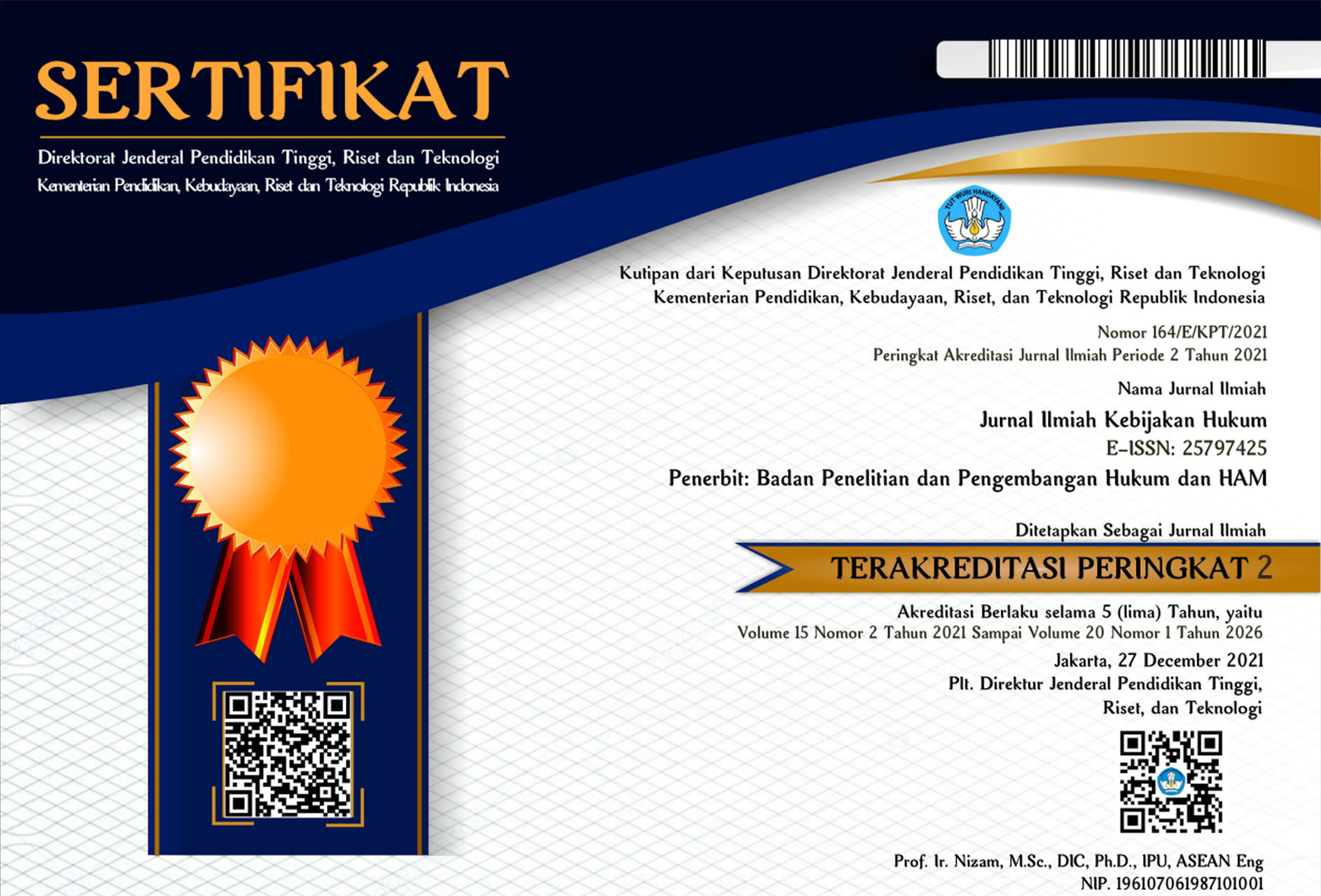An Analysis of Electronic Services Quality in Intellectual Property Using Gap Analysis and Importance Performance Analysis (IPA) as Public Service Quality Improvements
Abstract
Keywords
Full Text:
PDFReferences
Ahmad Jazuli. “Penyelesaian Permohonan Pendaftaran Paten Dalam Rangka Peningkatan Layanan Publik.” Jurnal Ilmiah Kebijakan Hukum 12, no. 3 (2018): 243–257.
Alan Neilson, Diane McGriffen, Derek Stewart, Mik Winewski. Can’t Get No Satisfaction? Using a Gap Approach to Measure Service Quality. Edinburgh: Accounts Commision for Scotland, 1999. publications@scot-ac.gov.uk.
Apriansyah, Nizar. “Analisis Layanan Publik Permohonan Pendaftaran Kekayaan Intelektual.” Jurnal Ilmiah Kebijakan Hukum 14, no. 1 (2020): 75–90.
———. “Jurnal Ilmiah Kebijakan Hukum.” Jurnal Ilmiah Kebijakan Hukum 14, no. 1 (2020): 125–140.
Aritonang, Dinoroy Marganda. “The Impact of E-Government System on Public Service Quality in Indonesia.” European Scientific Journal, ESJ 13, no. 35 (2017): 99.
Balitbangkumham, DJKI dan. Laporan Tim Pelaksana Survei Indeks Kepuasan Masyarakat Dan Indeks Persepsi Korupsi Direktorat Jenderal Kekayaan Intelektual Kementerian Hukum Dan Ham. Jakarta, 2018. https://dgip.go.id/index.php/unduhan/download/laporan-survey-kepuasan-masyarakat-pada-direktorat-jenderal-kekayaan-intelektual-kementrian-hukum-dan-ham-tahun-27-2018.
Carter, Lemuria, and France Bélanger. “The Utilization of E-Government Services: Citizen Trust, Innovation and Acceptance Factors.” Information Systems Journal 15, no. 1 (2005): 5–25.
Chee-Wee, Tan, Izak Benbasat, and Ronald T. Cenfetelli. “Building Citizen Trust towards E-Government Services: Do High Quality Websites Matter?” Proceedings of the Annual Hawaii International Conference on System Sciences, no. February (2008).
EDW, Evi Wahyuni, Dharma Pradana, and Yasina Karina. “E-Government Service Evaluation of Batu City Health Dept.Using e-Govqual Approach and IPA Analysis.” Proceeding of the Electrical Engineering Computer Science and Informatics 5, no. 5 (2018): 734–737.
Indonesia, Markplus. Laporan Akhir Analisis Hasil Survey Indeks Kepuasan Masyarakat Direktorat Jenderal Kekayaan Intelektual ( DJKI ). Jakarta, 2019. https://www.dgip.go.id/unduhan/download/hasil-survey-kepuasan-masyarakat-djki-2019-di-6-provinsi-oleh-lembaga-independen-27.
John W. Creswell. Research Design : Qualitative, Quantitative, and Mixed Methods Approach. 3rd ed. London: SAGE Publications, Inc, 2009.
Li, Hongxiu, and Reima Suomi. “Evaluating Electronic Service Quality: A Transaction Process Based Evaluation Model.” ECIME 2007: European Conference on Information Management and Evaluation (2007): 331–339.
Martilla, John, and John James. “Importance-Performance Analysis: An Easily Applied Technique for Measuring Attribute Importance and Performance Can Further the Development of Effective Marketing Programs.” Journal of Marketing, 1977.
Nugroho, Trisapto. “Analisis E-Government Terhadap Pelayanan Publik Di Kementerian Hukum Dan Ham (Analysis of E-Government to Public Services in the Ministry of Law and Human Rights).” Jurnal Ilmiah Kebijakan Hukum 10, no. 3 (2016): 279–296.
Nunnally, J. C., & Bernstein, I. H. Psychometric Theory (3rd Ed). 3rd ed. New York: McGraw-Hill, 1994.
Papadomichelaki, Xenia, and Gregoris Mentzas. “E-GovQual: A Multiple-Item Scale for Assessing e-Government Service Quality.” Government Information Quarterly 29, no. 1 (2012): 98–109. http://dx.doi.org/10.1016/j.giq.2011.08.011.
Parasuraman, A., Valarie A. Zeithaml, and Arvind Malhotra. “E-S-QUAL a Multiple-Item Scale for Assessing Electronic Service Quality.” Journal of Service Research 7, no. 3 (2005): 213–233.
Parasuraman, A, and Valarie A Zeithaml. “A Conceptual Model of Service Quality and Its I-Mplications for Future Research” 49, no. 1979 (1985): 41–50.
Prijana. Metode Sampling Terapan Untuk Penelitian Sosial. 1st ed. Bandung: Humaniora, 2005.
Qadri, Usman Ahmad. “Measuring Service Quality Expectation and Perception Using SERVQUAL: A Gap Analysis.” Business and Economics Journal 06, no. 03 (2015).
RB, Menpan. Peraturan Menteri Pendayagunaan Aparatur Negara Dan Reformasi Birokrasi Republik Indonesia Nomor 15 Tahun 2014 Tentang Pedoman Standar Pelayanan. Vol. 15, 2014.
Rizq, Shafira, Moh Djemdjem Djamaludin, and Yani Nurhadryani. “Analysis of Service Quality Satisfaction of E-Ktp Service At Public Administration and Civil Registration Office of Bogor District.” Journal of Consumer Sciences 3, no. 2 (2018): 55.
———. “Analysis of Service Quality Satisfaction of E-Ktp Service At Public Administration and Civil Registration Office of Bogor District.” Journal of Consumer Sciences 3, no. 2 (2018): 55.
Sá, Filipe, Álvaro Rocha, and Manuel Pérez Cota. “From the Quality of Traditional Services to the Quality of Local E-Government Online Services: A Literature Review.” Government Information Quarterly 33, no. 1 (2016): 149–160. http://dx.doi.org/10.1016/j.giq.2015.07.004.
Saha, Parmita, Atanu Nath, and Esmail Salehi-Sangari. “Success of Government E-Service Delivery: Does Satisfaction Matter?” Lecture Notes in Computer Science (including subseries Lecture Notes in Artificial Intelligence and Lecture Notes in Bioinformatics) 6228 LNCS (2010): 204–215.
Saputra, Rino Agus, Suprapto, and Aditya Rachmadi. “Penilaian Kualitas Layanan E-Government Dengan Pendekatan Dimensi EGovqual Dan Importance Performance Analysis (IPA) (Studi Kasus Pada Pemerintah Provinsi Nusa Tenggara Barat).” Jurnal Pengembangan Teknologi Informasi dan Ilmu Komputer 2, no. 5 (2018): 1794–1802.
Siregar, T.E. Wijatmoko & M.U. “Evaluation of E-Government Service Quality Using e-GovQual Dimensions.” IJID International Journal on Informatics for Development 8, no. 2 (2019): 55–61.
Teo, Thompson S.H., Shirish C. Srivastava, and Li Jiang. “Trust and Electronic Government Success: An Empirical Study.” Journal of Management Information Systems 25, no. 3 (2008): 99–132.
Urban, Glen L., Fareena Sultan, and William J. Qualls. “Placing Trust at the Center of Your Internet Strategy.” MIT Sloan Management Review 42, no. 1 (2001): 39–48.
Wilujeng, Fuji Rahayu, Glisina Dwinoor Rembulan, Dicky Andreas, and Hendy Tannady. “Meningkatkan Kepuasan Pelanggan Pada Dua Bisnis E-Commerce Terbesar Di Indonesia Dengan Menggunakan Analisis Servqual Dan IPA.” Prosiding Seminar Nasional Sains dan Teknologi (2019): 1–9.
Wisniewski, Mik. “Using SERVQUAL to Assess Customer Satisfaction with Public Sector Services.” Managing Service Quality: An International Journal 11, no. 6 (2001): 380–388.
Yayu Yulianti. “Analisis Kualitas Pelayanan Pendidikan Dengan Menggunakan Gap Analysis Dan Importance Performance Analysis (Ipa) Pada.” Jurnal Pendidikan Ekonomi, 6, no. 2 (2017): 31–48.
Regulations
Act Number 25 of 2009 concerning Public Services.
Minister of State Apparatus Utilization and Bureaucratic Reform Regulation Number 15 of 2014 concerning service standard guidelines.
Minister of Law and Human Rights Regulation No. 42 of 2016 concerning Electronic Intellectual Property Application Services.
Director General of Intellectual Property of the Ministry of Law and Human Rights Decree Number: HKI-01.OT.02.02 of 2017 concerning the Determination of Intellectual Property Service Standards.
Article Metric
Abstract this article has been read : 1286 timesPDF file viewed/downloaded : 898 times
DOI: http://dx.doi.org/10.30641/kebijakan.2022.V16.153-174
Refbacks
- There are currently no refbacks.
Copyright (c) 2022 Junaidi Abdillah

This work is licensed under a Creative Commons Attribution-NonCommercial 4.0 International License.
Jurnal Ilmiah Kebijakan Hukum Indexed by :









